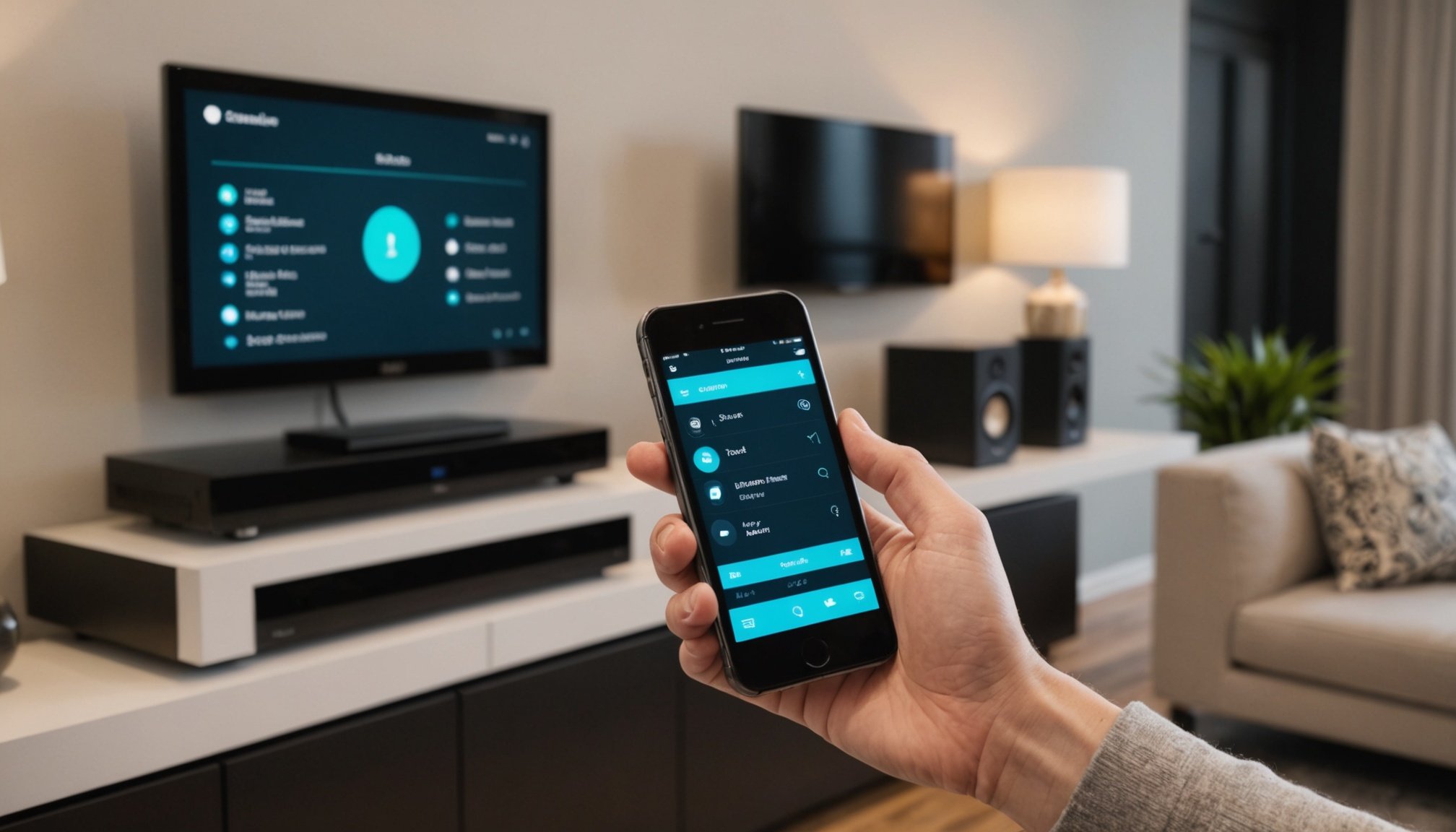Overview of Multi-Room Audio Management
Multi-room audio systems transform homes into cohesive soundscapes, enriching the smart home experience. They allow users to control and play music seamlessly across various rooms using interconnected speakers. This technology offers a unique blend of auditory aesthetics and functional convenience.
Importance in Smart Home Setups
Incorporating multi-room audio systems into smart home setups presents significant advantages. Integration with audio management apps ensures a streamlined way to control volume and playlists in each room, enhancing everyday life.
Additional reading : Maximize your mobile efficiency: innovative tips for streamlining app organization
How It Works
These systems typically rely on a network of wireless speakers connected via Wi-Fi. When harmonised with smart home integration, users can control their audio environment effortlessly using apps or voice commands. This seamless interaction between devices allows music and sound to flow without interruption, maintaining a harmonious audio atmosphere throughout the home.
Benefits of Audio Management
Effective multi-room audio management maximises the system’s benefits, offering flexibility and ease of use. It allows for:
This might interest you : Transform your home: cutting-edge strategies to integrate voice assistants with smartphone-controlled smart living
- Synchronising audio between rooms for consistent sound.
- Individual room control for personalisation.
- Enhanced entertainment experiences for parties.
When done right, multi-room audio systems significantly boost a home’s versatility, ensuring a smart home is as sonically impressive as it is intelligent.
Essential Apps for Multi-Room Audio Management
Managing a multi-room audio setup can be a breeze with the right tools. Some of the best audio management apps not only streamline audio distribution across several rooms but also enhance the quality of your auditory experience. Here’s a closer look at some top audio streaming apps and multi-room setup applications.
App 1: Sonos
Sonos is a front-runner among multi-room setup applications. Known for its seamless integration with a variety of audio devices, Sonos offers features like stereo pairing and customized room settings. It’s compatible with major streaming services, ensuring users can enjoy a diverse range of music. Reviews highlight its user-friendly interface and consistent performance, making it a preferred choice.
App 2: Alexa
The Alexa app stands out among the top audio streaming apps for its voice-controlled convenience and broad compatibility. Connecting with multiple audio devices, Alexa can manage playlists, adjust volumes, and even offer smart home interactivity. Users appreciate its ability to sync audio in different rooms effortlessly, providing a synchronized listening experience.
App 3: Google Home
Google Home excels in its intuitive control over multi-room audio setups. Its key features include voice commands for audio playback and compatibility with numerous audio systems. Praised in user reviews for its sleek integration with Google services, it also offers top-rated audio management functionalities. Its versatility makes it a valuable tool for tech-savvy audiophiles.
Features to Look for in Audio Management Apps
Exploring various audio management features in apps enhances your listening experience. The user interface design plays a crucial role in this. A well-designed interface ensures the app is intuitive and easy to navigate, allowing users to effortlessly access functionalities. This ease of use is essential in letting you quickly manage and adjust your audio settings.
Compatibility with a range of smart home devices is another critical factor. The ability to seamlessly integrate and control audio systems across different devices amplifies convenience. An app with broad compatibility ensures you won’t be limited to specific brands or types of equipment, adding flexibility to your audio setup.
In addition to basic functionalities, look for apps offering advanced smart audio app functionalities. For instance, room grouping allows you to manage multiple speakers in different rooms simultaneously. This feature is perfect for multi-room audio experiences, delivering synchronized sound throughout your home.
Moreover, sound customization options can significantly enhance your audio experience. Whether it’s adjusting bass levels or treble settings, having control over these essential app capabilities lets you tailor the sound to your preferences. Advanced features not only personalize but also elevate the auditory experience to suit diverse environments and occasions.
Setting Up Your Multi-Room Audio System
Creating the ideal multi-room audio configuration requires careful planning and execution. Whether you’re new to smart home audio installation or upgrading existing systems, a successful setup enhances your experience.
Step-by-Step Setup Guide
Kickstart your journey by exploring the app that comes with your audio system. Most audio system setups include a dedicated app guiding you through step-by-step installation. Begin by plugging in your speakers in their desired locations to avoid connectivity issues later. Ensure Wi-Fi compatibility, as a stable internet source is crucial for seamless operation.
Next, open the app to start the multi-room audio configuration. It typically discovers devices automatically, allowing you to assign names and designate their corresponding rooms. The key to flawless smart home audio installation is following instructions actively provided by the app.
Common Issues and Solutions
Even the smoothest audio system setup isn’t exempt from hiccups. Users frequently encounter challenges like network interruptions, which can be resolved by ensuring a strong Wi-Fi signal. If your system doesn’t recognize devices, reset each component, starting with the router. Finally, update firmware regularly to eliminate software-related bugs.
Tips for Optimizing Audio Quality
To maximize sound quality in varied environments, consider these suggestions:
- Position speakers at ear level.
- Minimize obstructions between speakers and listeners.
- Adjust equalizer settings to suit each room’s acoustics.
Explore these options to achieve optimal sound across every space.
Comparing Popular Multi-Room Audio Apps
In the realm of multi-room audio functionality, choosing the right audio app can elevate your auditory experience to a new level. Users have a variety of options, each offering unique features tailored to different needs. A precise comparison helps to differentiate between these audio apps.
Key Functionalities
When comparing audio apps, one should focus on factors like user interface differences, ease of navigation, and synchronization capabilities across multiple rooms. Top apps excel at seamless integration with smart home systems, offering intuitive layouts that enhance user experience.
Pros and Cons
For instance, some apps offer robust customization options but may lack in user-friendly interface, potentially impacting less tech-savvy users. Conversely, other apps might have straightforward designs, yet lack advanced features favored by audiophiles. Recognizing these trade-offs is crucial for making an informed decision based on your needs.
Visuals and Navigation
The significance of a well-designed interface cannot be overstated. Apps with clear, visual layout tend to outperform in user satisfaction, allowing for easy exploration through their features. Visual diagrams in some apps can guide seamless navigation, reducing the learning curve for new users and aiding in optimizing your audio experience across various rooms.
Tips for Effective Audio Streaming in a Smart Home
To create an immersive sound environment, optimizing your audio streaming experience is key. Follow these best practices to enhance your music listening across various devices:
Minimize Latency: Start by addressing the common issue of latency. Ensure your speakers and devices support high-speed internet standards such as Wi-Fi 6. This aids in faster data transfer, reducing delays between devices.
Maximize Sound Quality: Invest in speakers that support high-fidelity audio formats (like FLAC or ALAC) for superior sound. Use music streaming services known for their high-quality streams, like Tidal or Qobuz, to get every note crisp and clear.
Smart Streaming Techniques
Effective management of playlists and music sources can enhance your smart home audio streaming.
- Centralized Music Management: Use apps that control all your smart devices. This allows you to stream across multiple devices seamlessly and adjust volumes or change tracks without interruption.
- Smart Playlists: Leverage music AI for creating and maintaining playlists based on your preferences.
Explore these techniques and embrace a world of vibrant, uninterrupted audio in your smart home. With precision and the right tools, your audio streaming will transform ordinary listening into an extraordinary experience.
Integration with Other Smart Devices
In today’s connected world, smart home device compatibility plays a pivotal role in enhancing user convenience and satisfaction. Integrating your audio apps with popular smart devices can vastly improve your listening experience. Consider smart speakers like Google Home and Amazon Echo. These devices utilize audio integration techniques to seamlessly connect with various audio streaming apps, allowing for voice-activated control and playback.
The benefits of such integration are manifold. By incorporating smart devices into your audio setup, users can enjoy hands-free operation, swift access to playlists, and synchronicity across different rooms. This kind of integration ensures a fluid and dynamic multi-system audio management environment.
For instance, imagine arriving home and asking your smart assistant to play your favourite playlist; with seamless integration, the audio fluidly transitions from one room to another, maintaining uninterrupted harmony. Consider setups that include smart TVs, voice command modules, and sound systems to create an immersive experience.
Moreover, investing in compatible devices ensures future-proofing as more smart home technologies arise. As technology advances, staying updated with devices offering top-notch integration capabilities means you’ll always be one step ahead in implementing effective multi-device setups.
User Experiences and Reviews
Exploring user feedback on audio apps offers vital insights into the potential and pitfalls of smart home audio solutions. Customer testimonials frequently highlight satisfaction with seamless integration between apps and smart home systems. For instance, users commend certain platforms that allow for effortless control of multiple devices, enhancing daily routines.
Success Stories
Numerous customer testimonials describe success in achieving a more connected home environment. Users particularly appreciate audio apps that facilitate synchronization with various smart devices. This integration proves beneficial, especially when managing multiple gadgets is essential. Systems praised for intuitive interface design often earn rave reviews for ease of use and accessibility, enhancing user satisfaction.
Common Complaints
However, navigating these smart home systems isn’t without its challenges. A frequent gripe in customer testimonials centers on the occasional technical glitches that interrupt user experience. Smart home audio reviews also reveal dissatisfaction concerning app limitations, such as poor compatibility with certain devices or lack of user-friendly features. Users suggest improvements, like expanding audio app compatibility and refining user interfaces for better accessibility. Likewise, robust customer support is cited as a crucial area for enhancement, ensuring users feel confident in resolving technical issues promptly. Addressing these concerns can significantly elevate the user experience and foster greater satisfaction in the smart home audio ecosystem.
Visual Aids for Understanding Multi-Room Audio Management
Visual aids can significantly enhance the comprehension of multi-room audio management. Tools like screenshots and video demos are instrumental in demystifying complex audio apps for users. These visuals help convey step-by-step processes, allowing users to better grasp the practical applications of sophisticated audio systems.
Screenshots and Video Demos
Screenshots provide static references to the interface or particular settings within an audio app, highlighting essential features and functionalities. They serve as a quick, accessible method for users to pinpoint exact options or configurations.
Conversely, video demos offer dynamic, engaging tutorials that walk users through multi-room audio management processes. By observing an expert navigate through various settings and features, users gain a clearer understanding of best practices and innovative techniques. Video content is particularly valuable for visual learners who prefer observational learning methods.
Additional Resources and Guides
To further enrich user experience, comprehensive user guides for audio apps are indispensable. These guides should accompany visual aids, detailing nuances and offering solutions to common audio management challenges. Instructional media curated specifically for multi-room audio setups can be invaluable, providing a curated collection of tips, advice, and error troubleshooting steps.
Leverage sources like manufacturer websites or trusted online tech communities for accessing these educational materials and keep your audio environment optimally managed.











